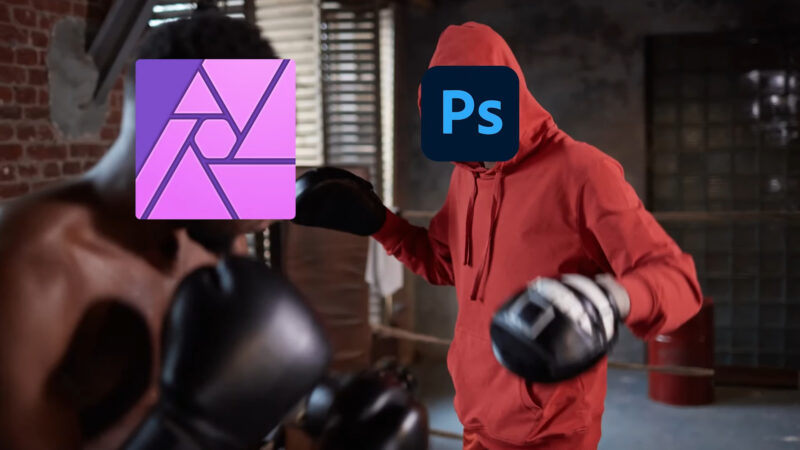Affinity Photo or Photoshop, which one to pick (and why)?
We researched and tested these programs to see how they stand against each other. Read our unbiased Affinity Photo vs. Adobe Photoshop comparison to make a smart decision.
Affinity Photo is a raster-based, powerful photo-editing program. Serif created the Affinity line in 2015.
Adobe Photoshop is one of the most popular programs in the world. It is raster-based and created by Adobe in 1987.
If you’re in a rush, here is the summary of the comparison.
Comparison At a Glance
1. Features
Affinity Photo:
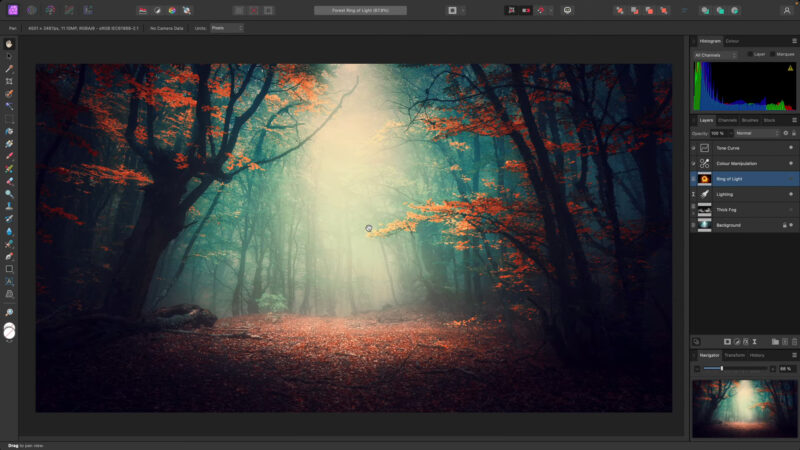
- Powerful photo-editing capabilities. The tools have a huge range of functionality, allowing the user to do very detailed edits.
- Professional Color Modes: Has full CMYK, RGB, RGB Hex, LAB, and Grayscale modes.
- Default software comes with many presets for photography in the Tone Mapping persona.
- Saves Undo History after closing a project for up to 8,000 steps. Undo History is a great feature that protects you against accidental changes and lets you restore old versions.
- Live Brush preview, allowing you to see the brush effect before you use it.
- Workspace divided into personas: Photo, Liquify, Develop, Tone Mapping, and Export. Different tools come up with each persona, allowing less confusion and better workflow as you edit a photo. The personas take you from the beginning to the end of the editing process.
- The Develop persona in Affinity is used to edit raw images. This workspace allows you to make simple edits on the raw image to prepare it for further editing.
- Macros: A feature that allows the user to do multiple operations as one action. For example, you could apply a filter and change the exposure. Instead of taking all of the actions every time, you can apply the one macro, saving you so much time with batch editing.
- Resize and move an image with one tool, Move. (The equivalent would be two tools in Photoshop, Resize and Move.)
- It can create vector shapes using the shape or pen tools.
- Affinity is very compatible with Adobe: Can import .psd files, import Photoshop brushes, use most Photoshop plug-ins, and edit from Lightroom.
- Has many templates to choose from, organized by output.
Adobe Photoshop:
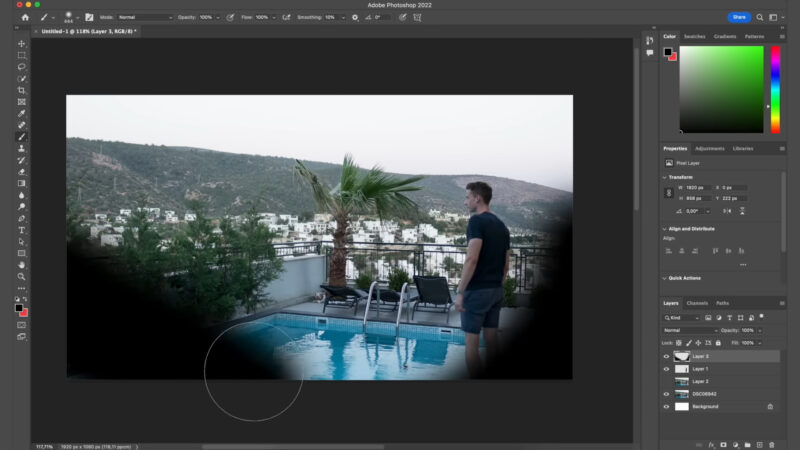
- Exceptional photo-editing capabilities. The tools at hand are extremely precise and powerful, giving artists the most control over their photos.
- Handles big files exceptionally well, faster at processing.
- Has access to Adobe Typekit, a font library with thousands of fonts at your disposal. They are very easy to download and offload with the activate and deactivate buttons.
- It has access to Adobe Stock, a huge collection of stock images you can use for your projects. Each asset has a licensed credit, credits that you can get via subscription or purchase one at a time.
- It can sync with Cloud Documents, a powerful cloud-based storage system that lets you access your designs from anywhere, allowing you to browse and download from other devices. Cloud Documents works especially well when switching to different devices. An example is a desktop to a tablet workflow.
- Adobe Photoshop works great with the other family of applications. In particular, Adobe Camera RAW is a great plug-in that lets you import and enhance raw images. Photoshop also works great with InDesign, Lightroom, and Illustrator, to name a few other applications. Adobe has over 20 applications in total.
- Actions: A feature in Photoshop where you assign a series of tasks to one action. Actions are a great way to speed up batch editing. Photoshop comes with predefined actions. You can also customize actions for your projects too.
- Huge library of tutorials and resources available through Adobe. There are also many lessons and tutorials available from the outside community.
- Has tons of templates to choose from, sorted by output such as Print or Mobile.
Affinity is missing some Adobe features. Unlike Affinity, Photoshop has 3D capabilities, animation, scripting, and a video timeline. Overall, Adobe Photoshop has more features than Affinity Photo.
Winner: Adobe Photoshop
2. Pricing
| Product | Regular Price |
|---|---|
| Adobe Creative Cloud | $52.99/month |
| Adobe Photoshop | $20.99/month |
| Affinity Photo | $49.99 (one-time) |
Overall, Affinity is the cheaper software. You only have to pay a one-time fee versus Photoshop’s subscription plan.
Affinity Photo is available for $49.99 as a one-time purchase. In Affinity’s shop, they offer supplementary brush bundles and illustration kits at an additional price. If you want the iPad version, you have to pay an additional $20.00.
Adobe Photoshop is only available via subscription. While you can get discounts as a student or teacher, the lowest base rate is $9.99/month on annual terms for the Photoshop & Lightroom bundle. If you want to cancel month-by-month, the cheapest plan is $31.49/month for just Photoshop. You do get the iPad version included in the subscription.
Affinity gives you free updates until the next version of a product. Usually, you will then get free updates for several years until they have a new big release. Meanwhile, the Adobe subscription includes the updates for life, but you must always have an active subscription.
An aggravating fact was that Adobe Photoshop used to be available as a one-time purchase from Adobe. Now, however, you can’t use Adobe Photoshop at all unless the subscription is active. In comparison, the one-time purchase of Affinity Photo makes it even more appealing. Because it’s a one-time purchase, you will always have some software version on hand even if you don’t want to pay for the newer version.
Overall, Adobe would get more expensive than Affinity within several months. Subscription fees add up fast. Affinity’s one-time purchase is worth it.
Winner: Affinity Photo
3. Longevity
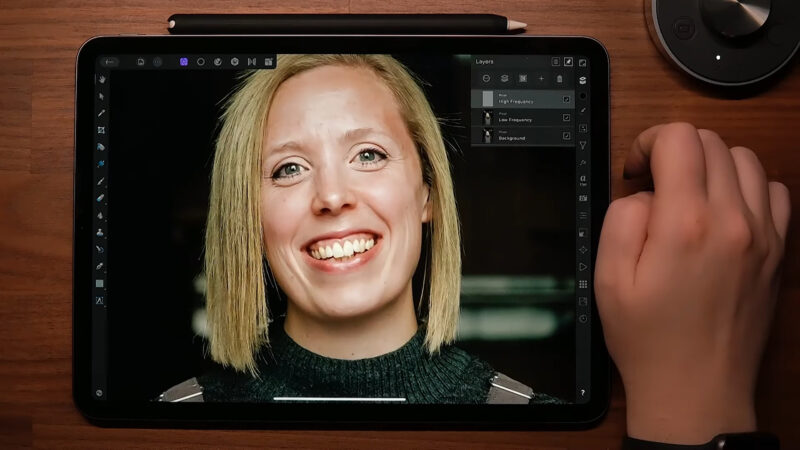
Overall, Adobe Photoshop is the winner in terms of longevity. Affinity doesn’t have a huge family of applications supporting it and doesn’t have as many users. Adobe Photoshop is used by over 90% of the creative community.
Adobe programs are used everywhere. Many businesses get the Adobe Creative Suite because it has such a huge range of capabilities. There are programs for video editing, animation, vector graphics, web design, to name a few, plus Photoshop, all included in the same Creative Cloud bundle. Therefore, Photoshop and many Adobe programs are a requirement in creative jobs.
Because the creative community uses Adobe in the professional setting, Adobe products are often taught in college courses worldwide. Adobe can be considered an essential basic for a creative professional. While independent creatives may quit Adobe and use other software later, most know Adobe Photoshop.
Photoshop is a much older program than Affinity, made in the eighties versus 2015, the newer Affinity line released in 2015. Time and time again, Adobe has kept the program fresh and new, adding many features and bug fixes along the way. Granted, while some updates can be buggy, Adobe support guides users, and the errors get fixed pretty quickly. We will watch to see if Affinity can adapt to the fast-past world of software as quickly as Adobe.
Right now, Affinity doesn’t have a huge suite of programs. The trio right now consists of Affinity Photo, Affinity Designer, and Affinity Publisher. Affinity Designer is a vector-based program, comparable to Illustrator, and Affinity Publisher is a desktop publishing program, comparable to InDesign. If Affinity creates a bigger suite of applications, that will put them closer to Adobe’s scope.
Winner: Adobe Photoshop
4. User Interface
Both Affinity Photo and Adobe Photoshop have clean, intuitive user interfaces. They have different pros and cons to each.
Affinity Photo’s user interface is gorgeous. It’s all black, sleek, and easy to use.
The design behind both Adobe Photoshop and Affinity Photo is very similar. They have tools to the left, more panels to the right, and similar tabs up top. You can move panels around the workspace for both programs, the panels magnetically snapping to whichever side you want. Adobe allows you to save custom workspaces.
The biggest difference between Photoshop and Affinity is workspaces. Affinity Photo uses personas to divide up tasks, making the UI less cluttered. Adobe Photoshop can have personalized workspaces that you typically use one for your whole project. The preset workspaces include Essentials, Graphic and Web, 3D, Motion, Painting, and Photography.
Overall, usage feels very similar. The user movements are intuitive.
Winner: Tie
5. Compatibility
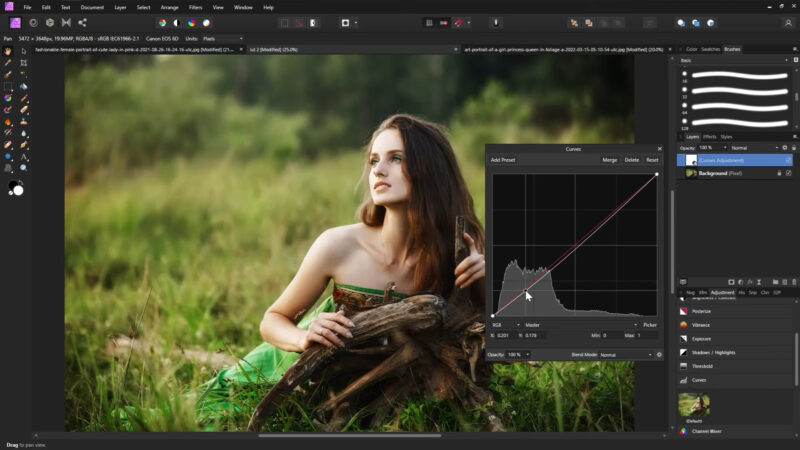
Both Adobe Photoshop and Affinity Photo work for Mac and Windows users. They also have an application available on desktop and iPad.
Affinity Photo works great with Adobe Lightroom. You can start an image in Lightroom and finish it in Affinity, just like you could finish in Photoshop. Most Adobe Photoshop plug-ins also work in Affinity too. You can also import Photoshop brushes into Affinity Photo.
However, Affinity files can only be opened with the Affinity program. This limitation makes it incompatible with many other programs. Photoshop files can be opened in a variety of external programs. CorelDraw, Krita, GIMP, and many Adobe applications can all open .psd files.
Overall, Photoshop is more compatible than Affinity. Photoshop works with a variety of outside programs and works seamlessly in the Adobe software world.
Winner: Adobe Photoshop
6. Workflow
Overall, Adobe Photoshop has a better workflow because of access to Lightroom. While Affinity has access to a few other programs, Adobe’s compatibility and custom settings make it a great choice.
Currently, Lightroom is one of the best photo management tools out there. It is great for organizing large amounts of photographs. But, Lightroom is part of the Adobe family. Currently, Affinity Photo doesn’t have an equivalent program of its own.
The RAW feature in Affinity Photo is also significantly slower than Adobe’s version. The lack of speed when processing the huge raw files can slow down the editing process.
Also, Adobe’s interface is customizable, allowing the user to save custom workspaces. Meanwhile, Affinity Photo is set in Personas. While both programs allow you to move around panels, Affinity is more rigid overall.
Both Adobe Photoshop and Affinity Photo have action tools, called Actions and Macros, respectively. Macros have a limited ability, while the Actions tool is broader. Both shorten the editing process by allowing the user to record multiple actions and combining them into one button.
Both Adobe and Affinity have tools that help speed up the workflow. Overall, Adobe makes the process easier as a whole.
Winner: Adobe Photoshop
7. Users
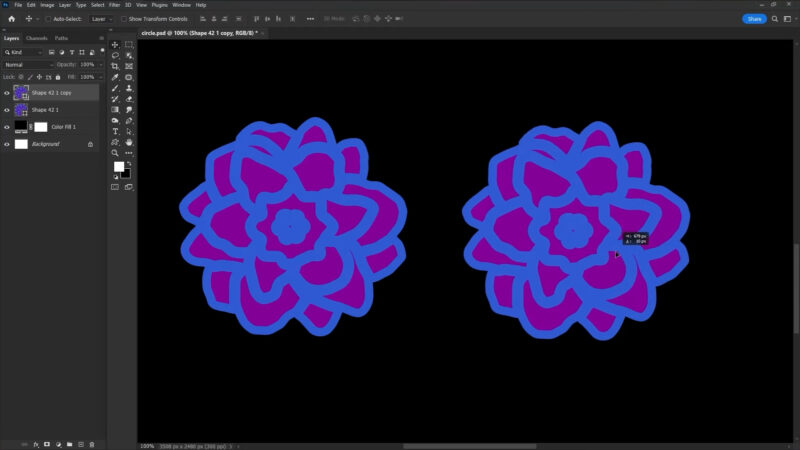
Both professionals and hobbyists use Adobe Photoshop and Affinity Photo. Depending on what you need the software for, Affinity Photo might be perfect for you. Photoshop is extensive and can be overkill depending on the user’s needs.
Many graphic designers and photographers have a set workflow when they use software and tend not to veer far from their habits. Affinity does the majority of what Photoshop does. Sure, it has a few fewer tools. But, if you aren’t using them anyway, why stick with Photoshop?
Affinity Photo has a great photo-processing workflow. It’s different than Adobe Photoshop but still does many of the same things. Using personas, Affinity guides you from beginning to end.
The reason that some professionals stay with Photoshop is that it works seamlessly with the Creative Cloud family. If you are already using the full suite, there is no reason to add Affinity to the mix.
However, for people who need a capable Photo editing software and nothing more, Affinity gets the job done.
All users use both programs. Affinity is tailored for people who need less range from their software. Adobe Photoshop is good people using the full Creative Cloud. In the end, they both have a wide audience.
Winner: Tie
8. Learning Curve
Both Adobe Photoshop and Affinity Photo have many tutorials and lessons online. They are complex programs with a ton of tools to master.
Adobe Photoshop has a 24-hour, Monday-Friday chat available for support. They also have an extensive community forum available to ask and look for questions about the software. There are professional community guides that will answer questions as well as fellow creatives.
Adobe also has an extensive tutorial library. Here, there are written lessons and video tutorials to guide you through everything from Photoshop’s basics to advanced lessons. There are also many external courses available through Skillshare, Lynda.com, and YouTube that teach users how to use Photoshop to the fullest. Photoshop also has in-app lessons, teaching you step by step on how to use many essential tools.
Affinity Photo has an index tutorial inside the application. Here, it lists all of the topics that you would use, subdividing it into lessons to give you a step by step guide.
Affinity also has community forums. Here, professionals and peers answer posted questions. You can also browse and search previous posts to see if those inquiries apply to you. While Affinity doesn’t have a chat or phone feature, they do have email support.
Affinity offers an online Start Guide, guiding you through the basics of Affinity as a beginner. They have also offered a hardcover workbook, at an additional $49.99, teaching you and offering lessons on Affinity Photo.
If you are a newbie who has never used a photo-editing software like Photoshop or Affinity, then you will find the software hard to learn. Layers, digital editing, painting, pixel vs. vector, and filters can be foreign concepts for beginners. If you already have worked with Photoshop or Affinity, the change won’t be that difficult. The two programs have many similarities in terms of usability.
While Adobe is more extensive than Affinity and, therefore, more complex, the support system is more robust and complete. Affinity is slightly more intuitive and less overwhelming than Photoshop. In terms of the learning curve, these two are equals.
Winner: Tie
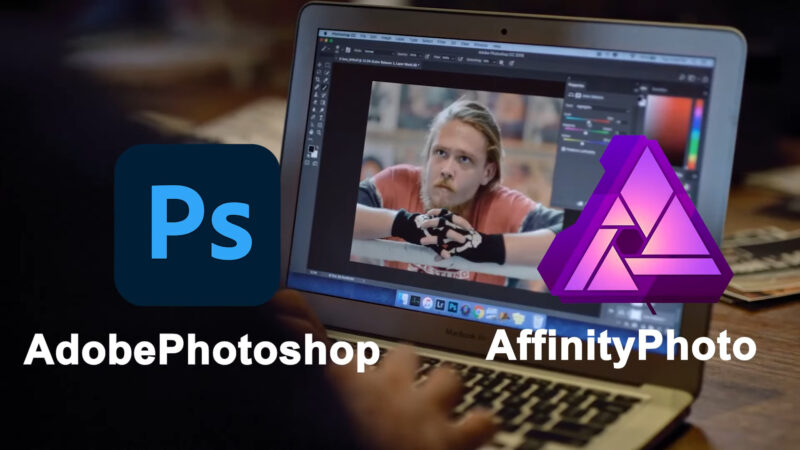
Frequently Asked Questions
Can I use Photoshop brushes in Affinity Photo?
Affinity Photo allows the import of Photoshop brushes, but compatibility might vary depending on the complexity of the brush.
Is there a subscription model for Affinity Photo?
No, Affinity Photo only offers a one-time purchase model, without a subscription.
Does Photoshop offer any mobile app?
Yes, Adobe offers Photoshop Express and Photoshop for iPad, catering to mobile editing needs.
Can I edit RAW files in both programs?
Yes, both Affinity Photo and Adobe Photoshop support RAW file editing.
Is cloud storage available with Affinity Photo?
Affinity Photo doesn’t offer its own cloud storage, unlike Adobe’s Creative Cloud storage offered with Photoshop.
Does Affinity photo offer a trial version?
Yes, Affinity Photo usually offers a trial version, allowing users to test the software before making a purchase.
Is there a significant difference in file sizes between Affinity Photo and Photoshop?
File sizes can vary based on the project, but generally, Photoshop files (.psd) tend to be larger due to the software’s more extensive feature set. Affinity Photo files (.afphoto) may be smaller but are not as universally accessible.
How do the color management systems compare between the two programs?
Both Photoshop and Affinity Photo offer robust color management systems, with support for various color profiles and spaces. Photoshop, however, has a slight edge in terms of integration with other Adobe products and industry-standard color profiles.
Can I use Affinity Photo files in Adobe InDesign or Illustrator?
Affinity Photo files need to be exported in a compatible format (like PSD or PDF) to be used in Adobe InDesign or Illustrator, as native Affinity files are not directly supported in Adobe products.
Final Thoughts
Both Affinity Photo and Adobe Photoshop are powerful programs. Which one should you get? That depends on what your needs are.
If you currently only work with Adobe Photoshop and want to find a budget-friendly alternative, switching to Affinity Photo makes sense. You will save a ton of money and do almost everything that you can do in Photoshop.
If you currently use many of the Adobe programs, getting Affinity wouldn’t be the right choice. Photoshop does more than Affinity Photo and works seamlessly with the Creative Cloud Suite. If you have the full Suite, Affinity Photo would be an additional expense on top of the subscription you’d already be paying for.
